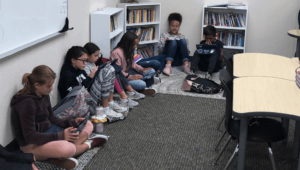5 Tips To Kickstart Your Classroom Technology Integration

By Maria Petrovska
We live in a digital world where everything evolves rapidly. What’s considered new and modern today can be old and obsolete tomorrow. That seems to go for almost everything in our lives as teachers as well, but one of the areas where we are seeing the most drastic evolution is definitely technology.
The marriage of classroom and technology does not really come as a surprise. As students began relying more and more on their digital sidekicks to get through the day, teachers have had to find a way to meet them in the middle. So it is relatively safe to say that the latest inventions have enabled us to start improving the traditional educational system, and will undoubtedly provide us with progressively engaged classrooms in the future.
The opinions on this subject are still divided. Some say that the change in educational trends is for the better, others for the worse. In the end, what’s important is that both sides agree the future course of education involves using some type of technology.
To keep pace with the current trends, we need to show our students that we are not outdated. We need to use the latest tech tools as well–and not just to be able to engage our students and make knowledge more fun for them, but also to make life easier for us.
If we pay close attention to what exactly makes our students happy, it’s pretty clear that it’s the new and dynamic (and fun) ways of learning that engage them most. So the logical conclusion would be to find new and effective ways of preparing and delivering lectures that students would find amusing and more challenging. If you think about it, it’s a win-win situation.
Here are five tips that can help you kickstart your classroom tech integration:
1. Create class groups on social networks. As an ESL teacher, I always strived to create a meaningful connection between myself and my students. The end goal is always to overcome the usual teacher-student paradigms and focus on positive engagement by establishing stronger relationships.
One way of doing this is to create closed class groups on social networks that enable everyone to freely communicate outside of the classroom. Also, check out apps like Remind that provide a different angle on teacher-student communication. In short, create a team atmosphere and use social networks to help you out.
2. Reuse old worksheets. Don’t throw away all of your paper just yet! An important part of using teacher technology integration is to make your job easier as well. Creating new assignments every time can be exhausting and time consuming. Thankfully, the new wave of web productivity tools enables us to simply repurpose old worksheets without manually retyping them.
For converting scanned PDFs to Word I mainly used this free online OCR tool, but for more complex document conversions it’s better to stick with a complex desktop tool, such as Able2Extract 10.
3. Record your lectures online. Fun fact: most students today love to watch videos. Therefore, educators can use video platforms to kick our lessons up a notch as well. Two tools you should check out are:
- TED-Ed is an online lessons repository that allows teachers to create their own video lessons and help students learn in a more interactive way. Lesson records can be really useful for distance learning as well.
- TeacherTube is a one stop online shop for free user generated educational videos from around the world. So you don’t need to reinvent the wheel every time–you can find exactly what you’re looking for with a quick search. Plus you never know–recording your lectures for online use might help you improve your game as well.
4. Create case studies. Delivering boring, routine lectures is simply not doing the job anymore (to be honest, I don’t think it ever did). The way to improve our students’ performance in life is to get them to think and come up with different solutions to various problems.
Traditional pedagogy will not help here since it doesn’t really involve team work. To develop students’ analytical thinking and problem solving skills, we need to create different case studies that place students in “real-life” situations. Try using this case study guide to get started. Step outside the box and you will undoubtedly fulfill your mission as an educator.
5. Create educational games and quizzes. Some teachers have already embraced the fact that students can actually learn through fun lectures and are making the most of it. You can do so as well. There are tools made especially for tackling this task, such as KaHoot. KaHoot is a tool that assesses students’ knowledge and encourages them to learn through playing games. Be sure to also check out free tools that can help create quizzes through which students can learn, compete and play at the same time.
Bill Gates once said that technology is just a tool, and in terms of getting kids working together and motivating them, the teacher is most important. Hopefully, these five tips can help you make the first step in that direction.
For more, see:
- 5 Ways To Use Social Media in the Classroom
- How to Integrate Professional IT Tools into the Classroom
- Why Should We Use Case Studies in the Math Classroom?
Maria Petrovska is a digital marketing manager for Investintech.com and a former ESL teacher.
Stay in-the-know with all things EdTech and innovations in learning by signing up to receive the weekly Smart Update.





Ronnie Teja
This post really looks very interesting to me. I learnt a lot today.
Anestesia Deniz
Your post information is very unique and useful for all readers.